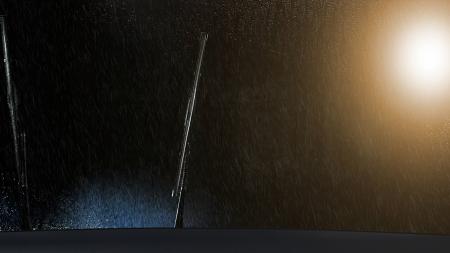Rasender Stillstand (Installation) Anna Anders
2021, 4K video, 2 channel video installation.
Length: 8:12 min (large flat screen monitor 48" to 55") and 41:51 min (small digital photo frame 9") with news from January (11:53 min) and February (29:58 min), 2020.
A wall-mounted flatscreen, i.e. the "ground glass", becomes the windshield of a car that seems to be driving through heavy rainy weather (=tears) in the dark of night. At regular intervals, the windshield wipers clean the (monitor) window like the blink of an eye. From the car radio one hears reports about the first two months of the Corona Pandemic, i.e. January and February 2020.
With the central-perspective view of a first-person shooter, the viewer seems to drive through an uncomfortable and obscure world, with a fixed gaze directed into the distance, but never arriving anywhere (loop). One literally drives against the wall.
On a mini-monitor (the speedometer) not the speed is measured, but the days we are racing past. On the "car radio" appears the date of the message to be heard. We "learn" about the spread of an unknown virus and what protective measures are recommended and taken.
Background info:
The title "Rasender Stillstand" refers to Paul Virillo's 1987 essay of the same name, published in the book of the same title that appeared in French in 1990 and in German in 1992.
I think the title describes today's times very well and it can also be understood as furious standstill, as in "furious with rage."
In my research, I first realized that Virillo's text is understood, not only by me, as an apt description of the current "Corona crisis." Mostly, however, it is interpreted in a very one-dimensional way, namely as if the pandemic had (finally) put an abrupt end to our restless and wasteful life before and we are now slowed down and forced to think and turn around.
But actually this is not about a succession (first the unbridled life and then the prison sentence), but rather about the schizophrenic state of a simultaneity of enormous acceleration of digital communication with total paralysis of the body. "Swept along by the tremendous violence of speed, we move nowhere." (Virillo) and "The greater mobility becomes, the greater control becomes." (Virillo).
Young people race through virtual landscapes and war zones as first-person shooters in their computer games, work their controllers with their nimble fingers, and become fat and clumsy themselves because they no longer move from the couch.
According to Virillo, the new techniques of instant interactivity have made us "much closer to what is far away than to our immediate neighbor, increasingly detached from ourselves." This loss of one's own body leads, according to Virillo, to the "void" of a virtual environment, a space-time whose telecommunication technologies are both the origin and the end." First people were fixed in houses, then in "automotive furniture" and means of transportation, then by telepresence (Virillo) - a journey without a journey and a locomotion without locomotion (Virillo)
Anna Anders


